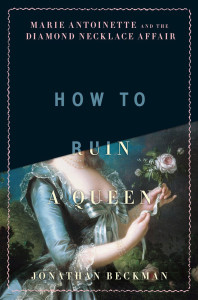(Jonathan Beckman; 386 pages; DE CAPO PRESS/PERSEUS BOOKS GROUP; 2014)
I’m a history buff; I love studying and reading about America’s past and the people who have molded us (for better or worse) into who we are today. However, when it comes to French history, here’s what I know: Notre Dame signed a deformed bell-ringer to play hunchback… I mean, fullback, even though he kidnapped a dancing girl and was charged with murder; a homeless dude with bad skin took up residence under the Paris Opera, causing major problems for performers; some guy named Napoleon wrote the hit single, “Waterloo,” for ABBA and, for his crime against humanity, was sent on a permanent vacation to a resort island called “Elba.” Plus, the country’s leadership usually folds like a cheap hammock rather than defend home and hearth.

Actually, I do know a bit about the storming of the infamous prison, the Bastille, and the Revolution with which that action was associated. That’s the one that supposedly prompted the Queen, Marie Antoinette, to exclaim, “Let them eat cake.” when told that the people of Paris were starving. As a result of that revolution, the monarchy was overthrown and, eventually, a despot named Napoleon Bonaparte named himself emperor and sought to expand the empire through military might. He was, indeed, exiled to Elba, though he escaped a year later and recaptured the throne of France only to meet ultimate defeat three months later against the British at Waterloo. This time he was exiled to the island of Saint Helena, where he died. Wow… I guess I know a little bit more about French history than I thought! And then, there’s the incident – commonly referred to as the Diamond Necklace Affair – explored by Jonathan Beckman in this new book. If not the specific reason for the revolt, it was certainly sewn into the fabric and… I knew absolutely nothing about it.

So often, books on historic subjects are very dry and rather analytical. Terms like “very dry” and “rather analytical” are reviewer speak for “boring” or, more accurately, “B-O-R-I-N-G!” This book is anything but. No one can say with any great authority exactly what happened and exactly who was involved in the caper, since very little remains as far as records and unbiased memoirs from the period. Beckman has done an amazing job of pulling together every existing court record, memoir, oral history and rumor about the Court of Louis XVI, the theft (and subsequent possible fates) of the necklace and the other principal and ancillary people who were even marginally involved. There is enough intrigue, lust, power-mongering, lies and deceit to keep anyone interested as they try to unravel what happened to the extravagant necklace created for (and ultimately rejected by) the Queen of France. The narrative style reads as much like a detective thriller as it does a historical treatise.

The entire affair centers around a young woman, Jeanne La Motte-Valois (nee: de Saint-Remy), who claimed to be descended from French royalty. While there does seem to be – at least – enough evidentiary remnants to support her claims, there were a laundry list of consequences that kept her from benefiting from her supposed ancestry. Jeanne continued to pursue the lifestyle that she felt was her birthright, most often to the detriment of all around her. She used those who cared for her, discarding them once they had outlived their usefulness to her self-consumed cause. One of those people is the other major player in the game: Cardinal Louis de Rohan. The Cardinal was highly motivated by the possibility of upward mobility but, having fallen out of favor by the Queen, his ambitions were effectively stifled. Jeanne realized that the malleable Rohan and his desire to reingratiate himself with the Queen and at Court could help her in her quest to regain her rightful place (and the wealth that accompanied said place) among the French aristocracy. The introduction of the overtly gaudy necklace (2,800 carats) was nothing more than a happy coincidence as far as Jeanne was concerned. From the point she decided to use the jewelry for her own greedy means, the “conspiracy” embroiled the jewelers responsible for the piece, the Church, several families of French nobility, a young prostitute, shady lawyers, at least three governments, five countries, the infamous Count Cogliostro, the King and Queen of France and their Court. The lies perpetuated by Jeanne and her husband/confederate, Nicolas de La Motte, nearly brought down the monarchy and the Church and precipitated the Revolution that did bring an end to the monarchy system shortly after the trials of many of those directly involved (and two who simply had the bad luck to show up in Paris a short time before the whole scheme came to light, the Count and Countess Cagliostro).

So, bottom line, HOW TO RUIN A QUEEN is a great read whether you’re into history or not. Beckman’s research is impeccable; his writing style, entertaining and informative.By the way, one of the things I learned from this highly enjoyable book: Marie Antoinette never uttered the phrase, “Let them eat cake.” Apparently, the Austrian-born Queen of France cared more deeply for the poor and down-trodden of her adopted home than even her husband, the King. She may have been extravagant in her spending but, she would also disguise herself and bestow kindnesses on the less fortunate. Who knew?

